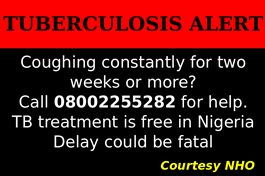Asthma still poorly diagnosed and inadequately treated – Prof. Erhabor
As Nigeria joined the rest of the world to mark the 2020 World Asthma Day on Tuesday May 5, renowned Professor of Medicine and leading Consultant Chest Physicians Professor Gregory Erhabor takes a look at asthma management in Nigeria and concludes that while the country seems to have made some progress over the years, the condition still remains poorly diagnosed and “inadequately managed,” due to low education, dearth of asthma medications and devices for managing the condition. Prof. Erhabor who is currently a lecturer at the College of Medicine, Obafemi Awolowo University and Consultant at the Obafemi Awolowo University Teaching Hospital Complex, Ile-Ife also explains the role of obesity as an emerging cause of asthma and the best approach to asthma management in the COVID-19 pandemic. EXCERPTS
‘World Asthma Day has improved public alertness on asthma’
As the world marks the 2020 World Asthma Day, can we say Nigeria is doing well in the area of Asthma management?
We have come a long way from where we used to be. The World Asthma Day (WAD) is an annual International event with goals to improve asthma awareness and care around the world. Several chest physicians across the nation now celebrate WAD yearly to increase awareness in all the geopolitical zones by educating healthcare professionals, patients, caregivers and the general public. This has improved public alertness thereby prompting quick response to patients with asthma when they need help.
Also, more resident doctors are showing interest in pulmonology and training to become chest physicians. This has resulted in more standardized ways of management in our various tertiary and secondary hospitals. Basic asthma medications, inhalational therapy and nebulizers are increasingly being used by a lot of hospitals and this shows some measure of progress. Although, this still runs short of what is expected and there is still a big divide between what happens in tertiary hospitals and primary and secondary care services.
For advancement of any disease, it is a triangle of patient management, training and research. There is still poor government involvement and active support to strengthen research and patient care in asthma in Nigeria. Moreover, asthma is poorly diagnosed and still inadequately treated even in tertiary hospitals because of poor education and lack of availability and affordability of asthma medications.
What is the prevalence rate of asthma in Africa as a whole and Nigeria in particular?
Asthma prevalence ranges from high prevalence countries like South Africa, which has a prevalence of 33.1%, to low prevalence countries like Gambia with prevalence of 4.4% while Nigeria prevalence falls in-between. Works that have been done in the ISAAC study and studies done by scholars in Nigeria shows that the prevalence ranges from 5% to 18.7% depending on the cohort being studied. Most studies show that there is an urban-rural gradient with more asthma being diagnosed in urban than rural areas. Anecdotal evidence had shown that about 15 million Nigerians may have asthma. Works have been done in different regions of Nigeria with varying prevalence rates and meta-analysis is being conceived to see if we can correlate all the studies together to come up with something that will be more representative of the asthma picture in Nigeria.
Apart from smoking and other activities that trigger asthma attacks, are there new risk factors Nigerians need to watch?
Basically, asthma results from interplay of genetic and environmental factors, a situation known as nature and nurture. Individuals with family history of asthma are prone to developing asthma. When individuals with genetic predisposition to asthma get exposed to certain triggers in the environment, they develop symptoms of asthma. Triggers are extremely small and lightweight particles transported through the air and inhaled into the lungs. They precipitate asthma attacks and are usually found in the environment. Triggers include pollens, house dust mite, cockroach allergens, cold air, spores, fumes, smoke, sprays, perfumes; exercise, certain drugs like aspirin, tobacco smoke, prolonged exposure to air pollution, and agents found at work place like chemicals, amongst others. People with allergies such as allergic rhinitis, conjunctivitis, sinusitis, or atopic eczema are predisposed to developing asthma. The most common trigger still remains house dust mite. However, there is new interest in the role of obesity in the development of asthma.
Prof. Erhabor
Can you please explain how obesity cause asthma?
Within the last few years, there has been a growing number of literatures on the obese asthma syndrome. The detailed discussion of this topic will be beyond the scope of this article. How obesity contributes to asthma in an individual may vary. However, these are a few ongoing factors that have come up as the relationship:
- Obese people are more susceptible to many strong risk factors of asthma like allergens, chemicals, cigarette smoking and air pollution. There are many things that have been attributed to it but one common one is that the diet that promotes obesity such as the western diet has high levels of saturated fatty acids, low fibers, low antioxidants and high in sugar. There is a growing literature that the harmful effects of these dietary components could lead to increased neutrophilic inflammation which predispose to asthma and increased bronchodilator response.
- Also, there has been some studies showing that obesity can lead to low circulating Vitamin D and vitamin D deficiency has been implicated in the development of asthma and obesity.
- There is also what we call a bidirectional relationship. Obesity predisposes to asthma and asthma also predisposes to obesity. For example, sixty percent of adults with severe asthma in United States are obese. Obese patients have worse asthma control and lower quality of life. Obese asthmatics do not respond as well to standard controller medications like inhaled corticosteroids and combination long-acting beta 2 agonists with inhaled corticosteroids (LABA/ICS), as non-obese patients. Furthermore, obese adults have 1.6 to 3 times more risk of developing wheeze and asthma.
- Obesity can cause or worsen gastroesophageal reflux disease (GERD) and sleep apnea and both of these conditions have caused increased risk of developing asthma.
- Patients with asthma who are obese usually have chronic low-grade systemic inflammation which is due to the release of certain pro-inflammatory chemicals (cytokines) in the body. One of these is Leptin which is synthesized by adipose tissue (fat tissue) and its levels in the body increases with obesity. Leptin and leptin receptors are found within the cells of the lungs, promote inflammation and contribute to bronchial asthma. High levels of leptin cause impairment of lung function, increased airway hyperresponsiveness (AHR) including exercise-induced bronchoconstriction and worsening of asthma symptoms.
Why is Asthma more prevalent in children than adults? Are there some genetic factors associated with it too?
Asthma is really not more prevalent in children as newer studies have shown. However, we need to do more multinational and intercontinental research to evaluate the prevalence because it appears asthma is still much underdiagnosed in both children and adults. Asthma runs a bimodal pattern – childhood asthma and adult asthma. Asthma tends to be more in number and in severity among boys than girls in childhood. This becomes balanced at puberty between the ages 12-14. However, between 15 to 50 years of age, females predominate. Early childhood events may influence the development of asthma, the so-called hygiene hypothesis. However, what determines the progression is being debated. Some believe once you develop childhood asthma you continue to have symptoms. Others believe that there is a rule of third; that following development of asthma, a third goes into quiescence, some recover and others progress.
“Early childhood events may influence the development of asthma” Pix: Courtesy The Guardian
In 2016, the Nigerian Thoracic Society predicted that about 100 million Nigerians will suffer from asthma in 2025 (in the next five years). According to the organisation, the country has 15 million sufferers from the lung disease out of over 350 million others believed to be suffering from asthma worldwide. What is your take on this?
I am not sure of that prediction of 100 million Nigerians having asthma. This is rather nebulous because the world prevalence of asthma is about 350 million. I think they may have been misquoted. I do not think Nigeria will have one-third of asthma sufferers in the world. Considering the current trend, that may not be possible but there could be increase in asthma prevalence as some of the factors responsible for asthma are still with us as industrialization takes over the rural environment.
In the face of the COVID-19 pandemic where getting medical attention is becoming difficult, how will you advise the average people living with asthma?
Management of asthma is usually a partnership between the physician and the patient with asthma. Asthmatics are encouraged to work with their physicians to develop a self-management plan which includes plan for acute exacerbation of asthma. Central to this management is the following:
- It must be individualized and personalized. There is need to study their asthma and treatment must be personalized for each person.
- Education is paramount. They need to be educated on asthma, the different components of asthma, how to recognize their triggers, inhaler techniques, self- management plan, amongst others.
- The early use of anti-inflammatory drugs which include inhalational steroids is advocated.
- Reserving rescue medications only for acute exacerbation. The lesser they are used shows a good management of their asthma.
- The use of combination therapy using long acting beta 2 agonists and inhaled corticosteroids (such as Budesonide/Formoterol, Fluticasone propionate/ salmeterol, Fluticasone propionate/ Formoteroletc) for long term maintenance of asthma. These medications can also be used as rescue medications. There are other newer drugs used in advanced countries but these are not readily available and affordable. However, with concerted efforts by pharmaceutical industries and interest by philanthropic bodies, we may be able to bridge the gap between the developing nations and more industrializes countries.
- As a principle, it is advised to take inhaled medications for asthma because it gets delivered to the site of action, and small doses give maximum effect. However, some inhaled medications can cause oral thrush and this can be prevented by using spacer devices or rinsing the mouth immediately after use.
- Monitoring of their asthma using a peak flow meter which allows them to calibrate their asthma because the peak flow meter has a colour-coded portion red, yellow and green. The Green zone shows you have good control, no asthma symptoms and you can continue to take your medications as usual. Your peak flow reading at this time is between eighty to hundred percent of your normal readings. The Yellow Zone is termed the zone of caution! The patient may have cough, wheeze, chest tightness or shortness of breath. He or she may be waking up at night due to asthma and can do some, but not all, usual activities. Use your inhaled bronchodilator with your anti-inflammatory medications and you may think of either changing medications or increasing dose. The Red Zone is the medical alert! The patient is usually very short of breath and quick-relief medicines have not helped. That person needs urgent attention.
- They should notice when their asthma is deteriorating for instance (i) when they have increasing symptoms of cough, wheeze, chest tightness and breathlessness, in spite of their usual medications (ii) when they have to use increasing doses of their usual drugs, (iii) when they have to use additional drugs to be able to sustain a certain level of control, (iv) when they have to wake up at night because of asthma symptoms or have to wake up more nights in a week because of asthma (v) increasing environmental triggers or stressful events that may increase their asthma (vi) when they find it increasingly difficult to do exercise or get breathless on mild to moderate exercise.
- A written self-management plan which will be personalized in case they have acute exacerbation of asthma.
Asthmatics should be managed as when there was no pandemic. When they notice deterioration in their health, they should contact the nearest health facility as soon as possible. The continual use of medications like aminophylline can be dangerous and should be discouraged. Early use of steroids is encouraged because of the anti-inflammatory properties.
What are the newer therapies in the management of asthma?
Severe allergic asthma could sometimes be very difficult to treat, in other words they may not respond to the commonly used asthma medications. In recent times, several new medications, known collectively as ‘biologics,’ have been approved for the treatment of moderate-to-severe asthma. Biologics are unique in that they target a specific antibody, molecule, or cell involved in asthma. Because of this, they are known as ‘precision’ or ‘personalized’ therapy.
A biologic is a medication made from the cells of a living organism, such as bacteria or mice, that is then modified to target specific molecules in humans. For asthma, the targets are antibodies, inflammatory molecules, or cell receptors. By targeting these molecules, biologics work to disrupt the pathways that lead to inflammation that causes asthma symptoms.
Some examples of these drugs include: Omalizumab, which targets allergy antibodies known as IgE and Mepolizumab, reslizumab, and benralizumab which all target pathways that affect eosinophils-which are cells involved in the disease process of asthma.The commonest and most widely used is Omalizumab particularly in Europe, the United States and other regions. These drugs are used as add-on therapies for the treatment of inadequately- controlled severe persistent allergic asthma, despite the use of high dose inhaled steroid and long acting bronchodilators in patients aged 6 years or over.
Among those who used these drugs, severe exacerbations were noticed to decline significantly.Omalizumab is given by underneath the skin injection once every 2-4 weeks based on initial serum IgE level and body weight.
The major drawback of these agents is the prohibitive cost. For example, a vial of 150mg for Omalizumab, cost on the average $1,188. Aside this, these drugs are not readily available in most low- and middle-income countries, like Nigeria. Another disadvantage is that they are mostly injectables and so they have to be administered in the hospital setting under strict monitoring.
Adverse effects such as fever, increase susceptibility to upper respiratory infection, headache, fever, urticaria, injection site induration, injection site itching, pain, and bruising all contributed to making the use of these medications not very desirable.
Other forms of therapy include Bronchial Thermoplasty which is an innovative, non-drug procedure developed for the treatment of severe persistent asthma. It involves the use of thermal energy to reduce the increased airway muscle that is associated with airway constriction in asthma patients and also to prevent permanent airway damage, otherwise called airway remodelling.
In recent time, experts have also advocated the use of Tiotropium which is a long-acting antimuscarinic agent. This drug works by relaxing the airways smooth muscles and reducing the increase mucus secretion associated with difficult -to-treat asthma.
With current COVID-19 pandemic, are more asthmatics presenting with COVID-19?
Current observational research has shown that asthmatics do not come up with increased exacerbation during COVID-19. But this is still evolving because COVID-19 affects the parenchyma of the lungs rather than the lung airways.
Perhaps asthma protects against COVID 19 via a different immune response elicited by the disease. ACE 2 receptor expressed in respiratory epithelium have been documented as the route of entry of SARS-Cov2 in humans. However, asthma patients have a decreased expression of these ACE2 receptors.
Therapies used by patients with asthma can reduce the risk of infection or of developing symptoms leading to diagnosis. Suppression of viral replication was shown, as the inhaled corticosteroid,ciclesonide, blocks coronavirus RNA replication by targeting viral NSP15. There have also been reports of the inhibitory effects of glycopyrronium, formoterol and budesonide on coronavirus HCoV-229E replication and cytokine production by primary cultures of human nasal and tracheal epithelial cells.
How best can one manage a severe allergic reaction like cough or wheezing during the lockdown that wouldn’t be misconstrued or taken for symptoms of COVID-19?
As doctors, we usually say that all that wheezes is not asthma. However, wheezing is not one of the symptoms in COVID-19. Cough in COVID-19 is dry, continuous, associated with fever, sore throat, muscle aches, breathlessness and other constitutional symptoms. Cough in asthma is usually episodic, associated with wheeze, breathlessness, chest tightness, and triggered by exogenous factors. Having said this, the best way to have diagnosis for COVID-19 is to do the testing and tracking of symptomatic and exposed individuals. If you are having symptoms suggestive of COVID-19, report to centers responsible for testing, tracking and managing the disease.
For asthma, diagnosis is from spirometry and demonstration of airway reversibility.
“Nebulizers are useful when patients are too young to cooperate, in the elderly who have poor co-ordination between device actuation and breath, or any condition that makes it difficult to use the inhaler therapy.”
At what point exactly do you place an asthma patient on nebulizer?
Nebulizer is a drug delivery device used to administer medication in the form of a mist inhaled into the lungs. Nebulizers break up medical solutions and suspensions into small aerosol droplets that can be directly inhaled from the mouthpiece of the device. They can be oxygen driven thereby giving a dual approach to effectively managing patients with asthma. There are various forms of nebulizers. These include the ultrasonic, jet powered and mesh nebulizers. These devices are basically used in managing acute exacerbations of asthma, chronic obstructive pulmonary disease and in the delivery of certain medications in managing other diseases. The aim of nebulizer therapy is to deliver a therapeutic dose of a desired drug as an aerosol in the form of respirable particles within a short period of time, usually 5–10 minutes.
The medications delivered via nebulizers can also be delivered using an inhaler with a spacer device and this may achieve the same result with a nebulizer. However, nebulizers are useful in acute settings. It is useful when patients do not have spacer devices, if they are too young to cooperateor in the elderly who have poor co-ordination between device actuation and breath, or any condition that makes it difficult to use the inhaler therapy. Research has shown that healthcare providers find it more convenient to administer nebulizers to patients in severe respiratory distress because less education or cooperation is required at such times, it can be oxygen driven, and it is less patient dependent.
There was a recent report where the writer was trying to link asthma to COVID-19 given the fact that many suspected severe confirmed coronavirus cases are always placed on ventilator when they complain breathing challenge. What are the correlations between a non-communicable disease like Asthma and COVID-19?
A recent chat I had with colleagues from the American Thoracic society revealed no increasing events of asthma episode in the COVID-19 pandemic. The use of ventilator in COVID-19 has a lot to do with increase in the lung fluids or what we call acute respiratory distress syndrome (ARDS).
The use of ventilator in asthma is reserved for patients who have life threatening asthma (whose asthma has progressed from acute severe asthma, have low oxygen (hypoxemia), high level of carbon dioxide (hypercapnia), has a silent chest etc). These set of people must be managed in the intensive care unit. However, when they are on mechanical ventilator, they continue their medications such as bronchodilators, oxygen, anti-inflammatory medications and are also given additional medications like magnesium sulphate and heliox.
In carrying massive awareness campaigns on asthma management, what strategies would you suggest to reach those who actually need such education?
I met with a group of experts in Tromso, Norway, about two years ago and we were thinking of the use of ‘M’ Health as a means of education, and managing patients with disease like asthma and COPD. ‘M’ Health is a term used for practice of medicine and public health supported by mobile devices like phones, tablets, computers, PDAs, variable devices that are smart etc. This is a very easy way in which you can use your smart device to track the patients; it also contains applications that can allow the patients to make informed decision on what to do and also connect with their physicians in very severe condition. That is an innovative step.
Other things that can be done include increasing public awareness through television, newspapers, radio, social media networks and using various public fora. There is also need for mass education in schools, churches and mosques and massive distribution of asthma information booklets.
How readily available are nebulizers and peak flow meters in our country?
Nebulizers and peak flow meters are now increasingly available in Nigeria compared to what used to happen in the past. OMRON has been actively involved in educating physicians, pharmacists and other healthcare practitioners globally on asthma and the use of peak flow meters, and other asthma devices like nebulizers. I am also aware that OMRON is collaborating with NEW HEIGHTS and they are involved in massive discounted sales of peak flow meters and nebulizers. Also, there are some pharmaceutical companies that distribute peak flow meters free to patients. There have also been some charity organizations like Asthma and Chest Care Foundation and Breathe Easy Foundation, UK, who have been actively involved in distributing peak flow meters free of charge to patients. However, this is not enough, we look forward to more participation by philanthropists to make nebulizers, peak flow meters and asthma medications available to the masses. One of my goals as a chest physician is to ensure that every asthmatic on the surface of the earth, especially in developing country, have a peak flow meter available to him or her.
On a final note, we want to commend bodies like the Nigerian Thoracic Society headed by Prof. Prince Ele for the work done on asthma in Nigeria. The Asthma and Chest Care Foundation, my foundation, has also been in the forefront in the provision of education, patient care and counseling, training of health professionals; advocacy and conducting of research projects towards the enhancement of the lives of people with asthma and other lung diseases. We look forward to philanthropists who will support these bodies so as to augment the efforts of the government in asthma management.
More Peak flow meter needed
About author
You might also like
Killers or saints: Examining TBA’s role in maternal health care (Part 1)
Women can’t just stop visiting them Despite the availability of robust healthcare services in Lagos, preference for Traditional Birth Attendants (TBAs) remains high. TBA Homes continue to thrive despite the
You should be dancing!
… To reduce risk of heart disease, stroke, Type 2 diabetes and certain forms of cancer According to experts, the human body is not designed to be still for a long time.
NMA raids illegal clinics, quack doctors in Aba
The Nigeria Medical Association, NMA, on Thursday, swept into action as it raided clinics in Aba, and fished out some alleged quack doctors. According to Vanguard newspaper, a number of







0 Comments
No Comments Yet!
You can be first to comment this post!